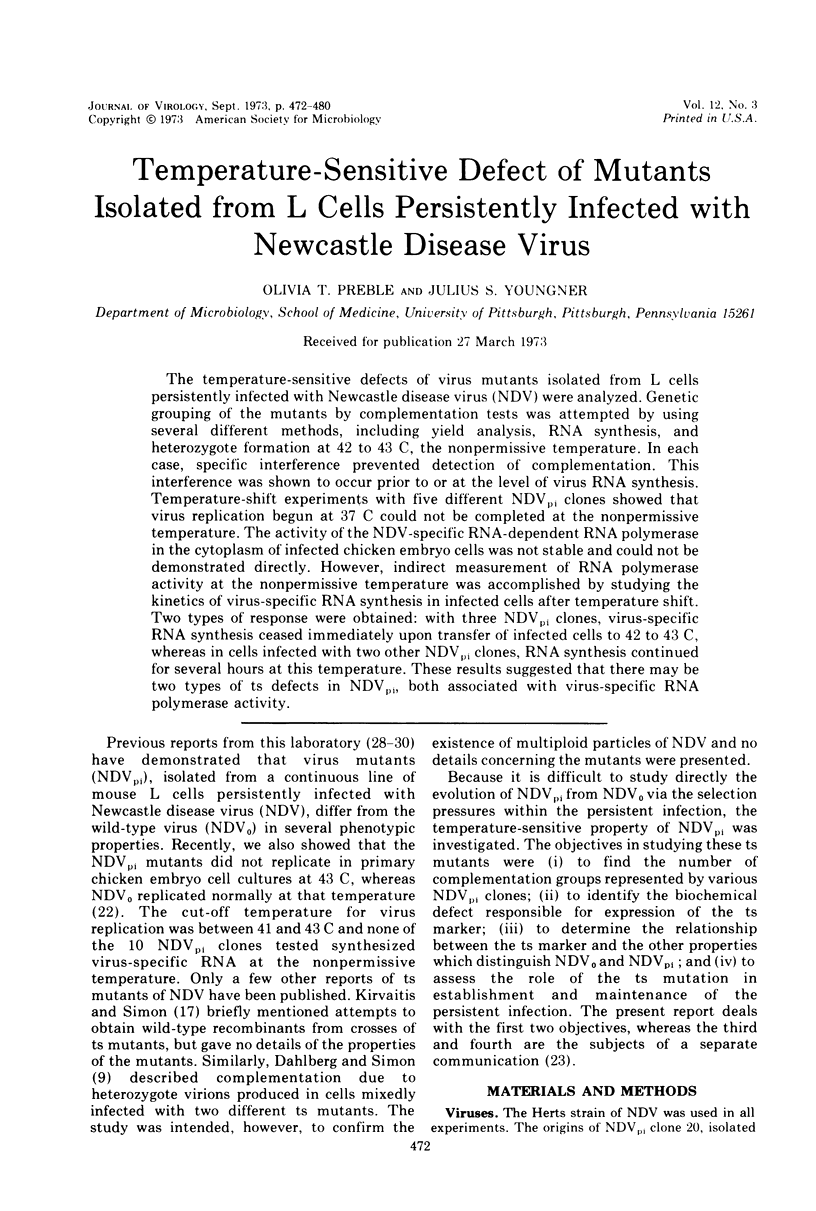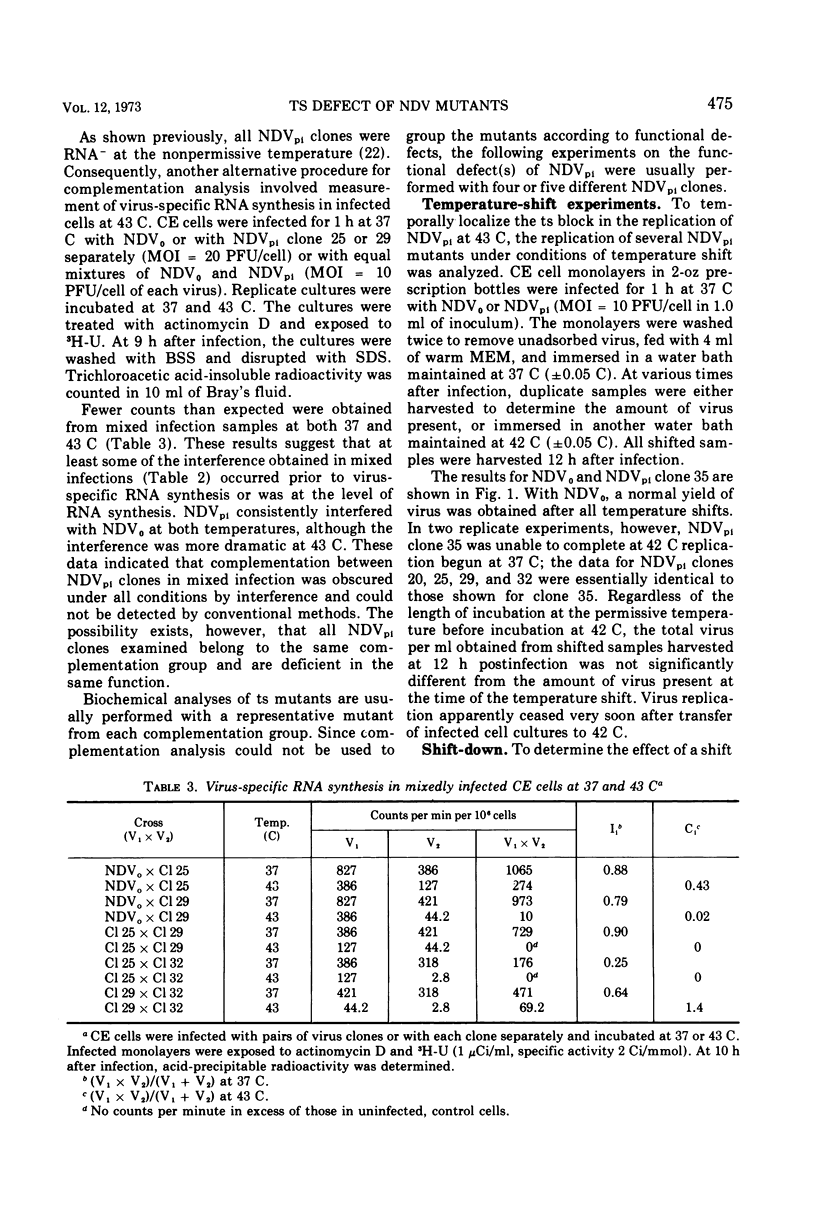Abstract
The temperature-sensitive defects of virus mutants isolated from L cells persistently infected with Newcastle disease virus (NDV) were analyzed. Genetic grouping of the mutants by complementation tests was attempted by using several different methods, including yield analysis, RNA synthesis, and heterozygote formation at 42 to 43 C, the nonpermissive temperature. In each case, specific interference prevented detection of complementation. This interference was shown to occur prior to or at the level of virus RNA synthesis. Temperature-shift experiments with five different NDVpi clones showed that virus replication begun at 37 C could not be completed at the nonpermissive temperature. The activity of the NDV-specific RNA-dependent RNA polymerase in the cytoplasm of infected chicken embryo cells was not stable and could not be demonstrated directly. However, indirect measurement of RNA polymerase activity at the nonpermissive temperature was accomplished by studying the kinetics of virus-specific RNA synthesis in infected cells after temperature shift. Two types of response were obtained: with three NDVpi clones, virus-specific RNA synthesis ceased immediately upon transfer of infected cells to 42 to 43 C, whereas in cells infected with two other NDVpi clones, RNA synthesis continued for several hours at this temperature. These results suggested that there may be two types of ts defects in NDVpi, both associated with virus-specific RNA polymerase activity.
Full text
PDF








Selected References
These references are in PubMed. This may not be the complete list of references from this article.
- BALUDA M. A. Homologous interference by ultraviolet-inactivated Newcastle disease virus. Virology. 1957 Aug;4(1):72–96. doi: 10.1016/0042-6822(57)90044-2. [DOI] [PubMed] [Google Scholar]
- BALUDA M. A. Loss of viral receptors in homologous interference by ultraviolet-irradiated Newcastle disease virus. Virology. 1959 Mar;7(3):315–327. doi: 10.1016/0042-6822(59)90201-6. [DOI] [PubMed] [Google Scholar]
- Bratt M. A., Rubin H. Specific interference among strains of Newcastle disease virus. 3. Mechanisms of interference. Virology. 1968 Jul;35(3):395–407. doi: 10.1016/0042-6822(68)90218-3. [DOI] [PubMed] [Google Scholar]
- Bratt M. A., Rubin H. Specific interference among strains of Newcastle disease virus. II. Comparison of interference by active and inactive virus. Virology. 1968 Jul;35(3):381–394. doi: 10.1016/0042-6822(68)90217-1. [DOI] [PubMed] [Google Scholar]
- Burge B. W., Pfefferkorn E. R. Complementation between temperature-sensitive mutants of Sindbis virus. Virology. 1966 Oct;30(2):214–223. doi: 10.1016/0042-6822(66)90097-3. [DOI] [PubMed] [Google Scholar]
- Burge B. W., Pfefferkorn E. R. Functional defects of temperature-sensitive mutants of Sindbis virus. J Mol Biol. 1968 Jul 14;35(1):193–205. doi: 10.1016/s0022-2836(68)80047-6. [DOI] [PubMed] [Google Scholar]
- Burge B. W., Pfefferkorn E. R. Isolation and characterization of conditional-lethal mutants of Sindbis virus. Virology. 1966 Oct;30(2):204–213. doi: 10.1016/0042-6822(66)90096-1. [DOI] [PubMed] [Google Scholar]
- DURAND D. P. Interference between viable strains of Newcastle disease virus. J Bacteriol. 1961 Dec;82:979–983. doi: 10.1128/jb.82.6.979-983.1961. [DOI] [PMC free article] [PubMed] [Google Scholar]
- Dahlberg J. E., Simon E. H. Recombination in Newcastle disease virus (NDV): the problem of complementing heterozygotes. Virology. 1969 Jul;38(3):490–493. doi: 10.1016/0042-6822(69)90165-2. [DOI] [PubMed] [Google Scholar]
- East J. L., Kingsbury D. W. Mumps virus replication in chick embryo lung cells: properties of ribonucleic acids in virions and infected cells. J Virol. 1971 Aug;8(2):161–173. doi: 10.1128/jvi.8.2.161-173.1971. [DOI] [PMC free article] [PubMed] [Google Scholar]
- Flamand A. Etude génétique du virus de la stomatite vésiculaire: classement de mutants thermosensibles spontanés en groupes de complémentation. J Gen Virol. 1970 Sep;8(3):187–195. doi: 10.1099/0022-1317-8-3-187. [DOI] [PubMed] [Google Scholar]
- Flamand A., Pringle C. R. The homologies of spontaneous and induced temperature-sensitive mutants of vesicular stomatitis virus isolated in chick embryo and BHK 21 cells. J Gen Virol. 1971 May;11(2):81–85. doi: 10.1099/0022-1317-11-2-81. [DOI] [PubMed] [Google Scholar]
- GRANOFF A. Noninfectious forms of Newcastle disease and influenza viruses; studies on noninfectious virus occurring within cells that are producing fully infectious virus. Virology. 1955 Dec;1(5):516–532. doi: 10.1016/0042-6822(55)90040-4. [DOI] [PubMed] [Google Scholar]
- GRANOFF A. Studies on mixed infection with Newcastle disease virus. II. The occurrence of Newcastle disease virus heterozygotes and study of phenotypic mixing involving serotype and thermal stability. Virology. 1959 Dec;9:649–670. doi: 10.1016/0042-6822(59)90155-2. [DOI] [PubMed] [Google Scholar]
- Huang A. S., Baltimore D., Bratt M. A. Ribonucleic acid polymerase in virions of Newcastle disease virus: comparison with the vesicular stomatitis virus polymerase. J Virol. 1971 Mar;7(3):389–394. doi: 10.1128/jvi.7.3.389-394.1971. [DOI] [PMC free article] [PubMed] [Google Scholar]
- Kirvaitis J., Simon E. H. A radiobiological study of the development of Newcastle disease virus. Virology. 1965 Aug;26(4):545–553. doi: 10.1016/0042-6822(65)90316-8. [DOI] [PubMed] [Google Scholar]
- Mahy B. W., Hutchinson J. E., Barry R. D. Ribonucleic acid polymerase induced in cells infected with Sendai virus. J Virol. 1970 Jun;5(6):663–671. doi: 10.1128/jvi.5.6.663-671.1970. [DOI] [PMC free article] [PubMed] [Google Scholar]
- Marcus P. I., Engelhardt D. L., Hunt J. M., Sekellick M. J. Interferon action: inhibition of vesicular stomatitis virus RNA synthesis induced by virion-bound polymerase. Science. 1971 Nov 5;174(4009):593–598. doi: 10.1126/science.174.4009.593. [DOI] [PubMed] [Google Scholar]
- Martin E. M. Studies on the RNA polymrase of some temperature-sensitive mutants of Semliki Forest virus. Virology. 1969 Sep;39(1):107–117. doi: 10.1016/0042-6822(69)90352-3. [DOI] [PubMed] [Google Scholar]
- Mills J., Chanock V., Chanock R. M. Temperature-sensitive mutants of influenza virus. I. Behavior in tissue culture and in experimental animals. J Infect Dis. 1971 Feb;123(2):145–157. doi: 10.1093/infdis/123.2.145. [DOI] [PubMed] [Google Scholar]
- Preble O. T., Youngner J. S. Selection of temperature-sensitive mutants during persistent infection: role in maintenance of persistent Newcastle disease virus infections of L cells. J Virol. 1973 Sep;12(3):481–491. doi: 10.1128/jvi.12.3.481-491.1973. [DOI] [PMC free article] [PubMed] [Google Scholar]
- Preble O. T., Youngner J. S. Temperature-sensitive mutants isolated from L cells persistently infected with Newcastle disease virus. J Virol. 1972 Feb;9(2):200–206. doi: 10.1128/jvi.9.2.200-206.1972. [DOI] [PMC free article] [PubMed] [Google Scholar]
- Pringle C. R., Duncan I. B. Preliminary physiological characterization of temperature-sensitive mutants of vesicular stomatitis virus. J Virol. 1971 Jul;8(1):56–61. doi: 10.1128/jvi.8.1.56-61.1971. [DOI] [PMC free article] [PubMed] [Google Scholar]
- Scholtissek C., Rott R. Ribonucleic acid nucleotidyl transferase induced in chick fibroblasts after infection with Newcastle disease virus. J Gen Virol. 1969 Jun;4(4):565–570. doi: 10.1099/0022-1317-4-4-565. [DOI] [PubMed] [Google Scholar]
- Stone H. O., Portner A., Kingsbury D. W. Ribonucleic acid transcriptases in Sendai Virions and infected cells. J Virol. 1971 Aug;8(2):174–180. doi: 10.1128/jvi.8.2.174-180.1971. [DOI] [PMC free article] [PubMed] [Google Scholar]
- Tan K. B., Sambrook J. F., Bellett A. J. Semliki forest virus temperature-sensitive mutants: isolation and characterization. Virology. 1969 Jul;38(3):427–439. doi: 10.1016/0042-6822(69)90155-x. [DOI] [PubMed] [Google Scholar]
- Thacore H. R., Youngner J. S. Cells persistently infected with Newcastle disease virus. 3. Thermal stability of hemagglutinin and neuraminidase of a mutant isolated from persistently infected L cells. J Virol. 1971 Jan;7(1):53–58. doi: 10.1128/jvi.7.1.53-58.1971. [DOI] [PMC free article] [PubMed] [Google Scholar]
- Thacore H., Youngner J. S. Cells persistently infected with Newcastle disease virus. II. Ribonucleic acid and protein synthesis in cells infected with mutants isolated from persistently infected L cells. J Virol. 1970 Jul;6(1):42–48. doi: 10.1128/jvi.6.1.42-48.1970. [DOI] [PMC free article] [PubMed] [Google Scholar]
- Thacore H., Youngner J. S. Cells persistently infected with newcastle disease virus: I. Properties of mutants isolated from persistently infected L cells. J Virol. 1969 Sep;4(3):244–251. doi: 10.1128/jvi.4.3.244-251.1969. [DOI] [PMC free article] [PubMed] [Google Scholar]


